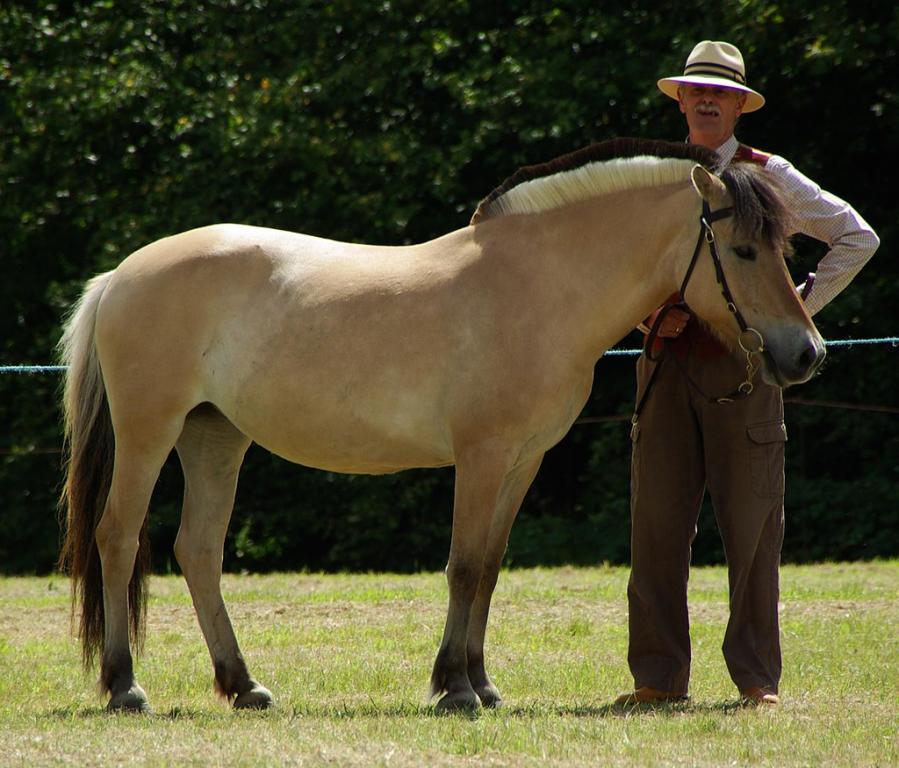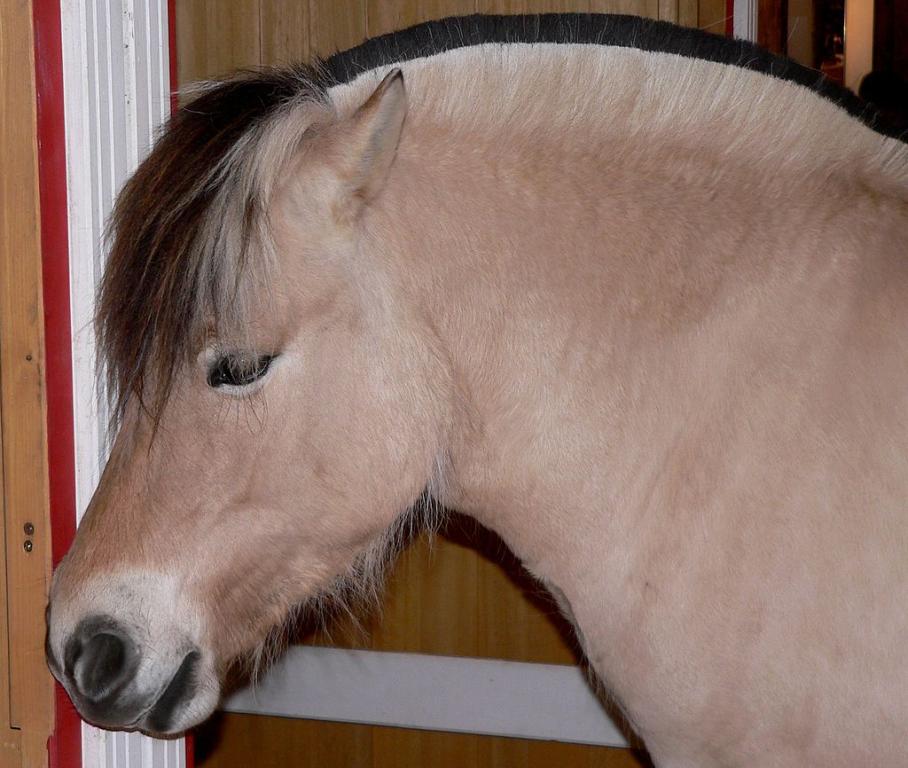
Continent: Europe
Country: Norway
Weight: 400 – 500 kg
Height: 135 – 140 cm

The Fjord horse is a very ancient breed native to the western coast of Norway, specifically the steep regions of Nordfjord, from which it takes its name. It is estimated that this breed has existed for over 2,000 years, descending directly from prehistoric horses that survived the Ice Age in the Scandinavian Peninsula. Thanks to the geographic isolation of these Norwegian valleys, the Fjord has maintained remarkable genetic purity through the centuries, without outside crossbreeding.
It is believed to have been used by the Vikings, both as a war horse, a pack horse, and a working animal. Archaeological findings have uncovered burials in which Fjord-type horses were placed alongside their riders. Starting in the early 20th century, the breed was rigorously selected, and in 1910, the official Norwegian stud-book was established, further reinforcing the breed's consistency.
Even today, the Fjord is considered one of the purest horse breeds in the world, with a stable type and a strong Nordic identity, reflected in its stocky morphology, its dun coat with primitive markings, and its gentle, willing temperament.
The historical homeland of the Fjord horse lies in the mountainous valleys of western Norway, particularly in the Nordfjord region, around Nordfjordeid, where the national breeding center (Norsk Fjordhestsenter) is still located today. This region remains the main breeding hub in Norway, with both family-run and institutional farms maintaining strict selection methods.
Outside of Norway, the breed began spreading in the 20th century to other northern European countries, notably Germany, Denmark, the Netherlands, and Sweden, where it is bred for its qualities in driving and leisure riding. Notable breeding programs also exist in France, especially in rural and mountainous areas, as well as in North America, where the Fjord is increasingly appreciated for its versatility, easy care, and gentle nature.
Today, although Norway retains official management of the stud-book, many countries have secondary or affiliated registries, contributing to the controlled dissemination and preservation of this iconic breed.
The Fjord horse holds notable genetic importance due to its exceptional breed purity and morphological stability. It is one of the rare equine breeds that has been minimally influenced by crossbreeding, making it a valuable resource for genetic studies and conservation programs.
Thanks to its natural hardiness, disease resistance, and reliable temperament, the Fjord is occasionally used in targeted crossbreeding programs aimed at enhancing rusticity, fertility, or cooperative behavior in other lines. Its ability to adapt to harsh climates and mountainous regions also makes it a relevant candidate for breeding in such environments.
Furthermore, its ancient genetic heritage, linked to prehistoric Nordic horses, gives it strong patrimonial value within European equine biodiversity.
The Fjord horse is one of the oldest and purest breeds in Europe. Native to Norway, it most likely descends from prehistoric wild horses that survived the Ice Age in the mountainous regions of Scandinavia. Archaeological evidence suggests it was already used by the Vikings, particularly for farming, transport, and even warfare.
Thanks to the geographic isolation of western Norway, the Fjord evolved without the influence of foreign bloodlines, maintaining a high level of type consistency. For centuries, it was an indispensable working companion for Norwegian farmers, valued for its strength, sobriety, and reliable temperament.
The breed began to be formally organized in the early 20th century, with the creation of a national stud-book in 1910, followed by the establishment of a breeding center in Nordfjordeid. Annual breeding shows are held there to evaluate stallions and mares according to strict criteria. The Fjord was later exported to other European countries and to America, where it found success thanks to its versatility.
Today, the breed is recognized worldwide as a symbol of Nordic tradition, and it continues to attract a broad audience for its distinctive appearance, its two-toned brush-cut mane, and its working abilities and connection with humans.
The Fjord horse is known for its calm, reliable, and well-balanced temperament. Naturally docile and cooperative, it generally forms a close bond with humans, making it an excellent companion for riders of all levels — including children and people with disabilities.
Despite its gentle nature, the Fjord remains a lively, intelligent, and willing horse, capable of taking initiative and responding quickly to training. It is particularly comfortable in activities that require patience, endurance, and consistency, such as driving, trail riding, or equine therapy.
Its exemplary behavior in varied environments, its high stress tolerance, and its ability to adapt make it a popular breed in both rural settings and riding centers. Its generous and steady personality continues to drive its growing popularity worldwide.
The Fjord horse is currently experiencing a renewed international interest, driven by growing trends toward gentle, versatile, and horse-friendly riding practices. Its calm temperament, reliability, and moderate size make it an ideal partner for equine therapy centers, riding schools, and nature-based equestrian tourism.
In the future, the breed may play an increasingly important role in alternative uses to traditional sport riding, particularly in educational, therapeutic, or sustainable projects. There is also a growing interest in driving and traditional skill demonstrations, where the Fjord excels due to its steady mindset and strength.
However, preserving genetic diversity remains a critical challenge. The Fjord’s extremely uniform type, while ensuring consistency, requires careful breeding management to avoid genetic drift or loss of variability. Norwegian authorities and affiliated associations abroad continue to work on structured genetic conservation efforts.
Overall, the outlook is positive, as long as the breed is protected through responsible breeding policies, and its qualities are promoted in modern contexts where functionality, simplicity, and gentleness are increasingly valued.
The Fjord horse is generally considered a very hardy and robust breed, with excellent natural resistance to common diseases. Its mountain origins have given it a strong constitution, good fertility, and notable longevity.
No major genetic predispositions or specific hereditary conditions are known, making it a particularly healthy breed. Its thick skin and hard hooves also contribute to very good hoof health, with few occurrences of laminitis or abscesses.
However, like all rustic breeds living in environments richer than their original habitat, the Fjord can be prone to weight gain and requires careful nutritional management, especially to avoid Equine Metabolic Syndrome (EMS) or issues related to overfeeding (lush grass, high-carb grains).
Regular weight monitoring, combined with sufficient physical activity, is usually enough to prevent these issues.
A slow, four-beat gait, very stable and energetic. The Fjord has a naturally strong, sure-footed, and regular walk, even on rough terrain.
A two-beat gait, energetic and active. The Fjord has a naturally well-balanced trot, often used in driving and trail riding.
A three-beat gait, less natural in the Fjord but comfortable and easy to improve through training. A smooth, round, and balanced canter.